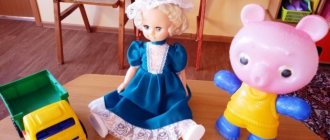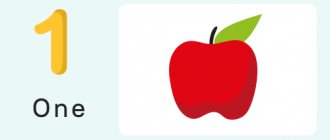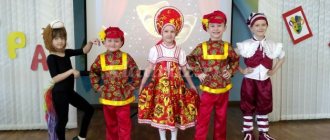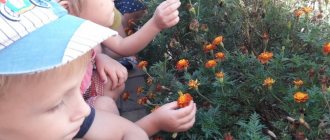Senior group. Senior preschool age. Children 5-6 years old
Summary of a drawing lesson for the senior group “Snowman” Department of Education of the Nizhny Novgorod City Administration Municipal Autonomous Preschool Educational Institution “Kindergarten No. 37”
(MADOU
"Kindergarten No. 37"
)
Summary of a lesson drawing techniques with children of the senior group 5-6 years old (within the framework of NOD...
Summary of the OOD on drawing with children of the senior group "Day of the Elderly" Municipal budgetary preschool educational institution kindergarten No. 13 combined type Summary of organized educational activities with children of the senior group on artistic and aesthetic development ( drawing )
on the topic
“Older Person’s Day”
Prepared and...
The Internet is the main assistant of the modern teacher
Well, there is some truth in this; we, preschool teachers, agree that it is time to change the program. But I want to defend our “conservatism” - there are decades-tested techniques and practices that really work, even applicable to today’s interactive children. And, in addition, in kindergarten we try to diversify joint activities as much as possible and add something non-standard to class notes.
And non-traditional fine art techniques are one of the ways to raise a creatively developed person.
So, regarding non-standard drawing methods, I personally definitely need to attend the webinar (and I advise you to), which is dedicated to classical and non-traditional materials in children's fine arts. Moreover, UchMag offers a tempting promotion - topping up your personal account and issuing a special webinar participant certificate.
From the literature, I would recommend the manual by G.N. Davydova “22 drawing lessons for preschoolers. Unconventional techniques,” which can be purchased at Ozone or UchMag. This is a good method by which you can compile a competent and interesting summary of unconventional drawing in the senior group, just in our topic. Parents will also find this book useful; it contains excellent materials about non-standard techniques for using paints and improvised objects.
An excellent gift for children would be the “I paint without a brush” set - it contains paints, various rollers, stamps, spatulas, and a design notebook. An inexpensive but cool set that will help your child become more daring in creativity, creative, as they say now.
Drawing. Lesson notes - Notes on drawing "Matryoshka" (senior group)
Publication "Summary of NOD for drawing "Matryoshka" (senior..." Goal: to continue to develop interest in the aesthetic side of the environment; to satisfy the needs of children in self-expression, the implementation of independent creative (visual) activities. Objectives: Educational: Teach independently, paint blanks of nesting dolls...
Summary of a drawing lesson in the senior group “My favorite toy”
Objectives: to develop creative imagination, the ability to conceive the content of one’s work, the ability to translate one’s ideas on paper, to evaluate one’s own work and the work of other children. Preliminary work: repeating poems by Agniy Barto from the “Toys” series, composing stories on the topic...
Summary of a drawing lesson in the senior group “Let's decorate Alyonushka's clothes with beautiful patterns” Topic title “Let's decorate Alyonushka's clothes with beautiful patterns” The goal is to introduce children to a new way of drawing using a stamp, to consolidate familiar methods and techniques of drawing Objectives Educational: to introduce children to the history of creation and technology performing Russian printed...
Summary of a drawing lesson “The girl is dancing” with children of senior preschool age
Priority area: Artistic and aesthetic development Integration of educational areas: RR; TFR; FR. Goal: To develop children’s ability to draw a human figure in motion Objectives: Educational: -Teach children to draw a human figure, conveying the simplest relationships in…
Drawing birds
Drawing a bird in the older group follows the same plan as the lesson on depicting animals. First, all details are compared with geometric shapes, attention is focused on movement, head tilt, and location on the landscape sheet. Here is an example (drawing a peacock):
- draw an oval body;
- a round head on top;
- the neck goes from the head along an oval;
- draw triangular wings on the body;
- add paws with three fingers to the oval;
- on the head you draw round eyes and a triangular beak;
- from one wing to the other, outline a loose tail, similar to daisy petals;
- color the bird with paints.
Drawing in the older group allows you to depict birds from different sides, in action. This is what the profile of a rooster looks like. You start working from the head. Draw a circle, mark the eye, a triangular beak with a transverse line, an oval beard and a comb of three petals.
From the head, draw a neck with a collar similar to the shape of a flared skirt. From it you continue the concave body, which together with the neck resembles a crescent. Next, draw a tail of eight feathers: the first long, raised up, four feathers starting from the end of the body, the last short, extending to a third of the body and hanging down.
On the body, a wing is drawn with a line, legs with four fingers and spurs. On the wing, sharp horizontal arcs indicate feathers, and vertical lines indicate long feathers. The claws are drawn on the fingers in small arcs.
Additional non-standard techniques
- Prints – there are many options here. Imprints can be made using almost any object: corks, potatoes, crumpled paper, foam rubber and anything that has an interesting texture.
- Stencils – there are ready-made stencils, you can make them yourself. But in any case, the technique is very interesting, but requires skill.
- Wet painting - we draw either on a pre-moistened sheet of paper or the finished drawing is lowered into a basin of water for a couple of seconds. It turns out very beautiful!
- Painting with a toothbrush - spraying. Paint is applied to the brush and sprayed onto a sheet of paper with a stick. You can also draw pictures with a toothbrush, depicting grass, animal fur, etc.
- Monotopy is a cool technique, everyone knows it. Take a sheet of paper and fold it in half. Then on one half we draw a picture or element with paints, bend the sheet, and get a mirror image. This is how you can paint water landscapes. You can also do it another way: we apply the design to the oilcloth, and then press the oilcloth to the paper. It turns out great!
- A scratchplate is something similar to an engraving. We draw chaotic strokes on white or colored paper. After drying, rub the surface with wax. Next we paint it completely with black gouache. Then we scratch the design with a skewer.
- Plasticineography - drawing with melted plasticine.
- Stained glass - a sketch is drawn on paper, maybe graphic. Then we apply a layer of PVA along the contour and let it dry. Next, the space inside the outline is painted as in a stained glass window.
- Drawing with sand, salt, scraps of paper. First, we draw on a sheet of paper with PVA glue, then we sprinkle some loose material on top, shaking off the excess. You can also paint on top of the drawing, it will turn out very unusual.
- The non-traditional drawing technique in the older group also includes templateography. We take various objects and trace them along the contour, selecting the shape so that in the end we get the intended object.
- Drawing with different objects: drinking straws, disposable forks, flat comb, toothbrush, wooden sticks, etc. Thick paints can be applied to paper with spatulas, rollers, or simply with your fingers, as I have already mentioned.
I wonder how you draw with children? Perhaps you have a personal patented drawing technique? Share with us?
It is clear that I have not listed all the methods, but I am talking about what I know myself. I advise parents to definitely try the listed image application techniques and report the results. Believe me, it is very exciting and useful for kids. You will thereby give children the opportunity to go beyond limits, to explore the endless possibilities of materials and imagination.
If you found the article informative, show it to your friends on social networks. I will be glad to see new subscribers to the news!
Sincerely, Tatyana Sukhikh! Till tomorrow!
What non-traditional methods of image transmission exist?
It should be noted that it is extremely important to use unusual drawing methods for children with developmental delays. They don't particularly like to draw, but they find it extremely rewarding to be creative. Therefore, you should show your child that there are many ways to depict something on paper. Remember that the child needs training; take the time to show the children how to draw using available objects.
A love of art instilled in children at an early age will help them grow into versatile individuals.
So, non-traditional drawing in the older group, and indeed for other age groups, involves the use of the following techniques:
- Finger painting - if little children simply like to dip their fingers in liquid and move on paper, then older children already make complex patterns or combine finger painting with other methods. At the same time, older children dip each finger in paint of a different color and try not to stain the white sheet of paper, but to make impressions carefully. If you put a print of an entire palm, then you can draw many different characters from the resulting print.
- Drawing with pokes - for this you take either a special brush with cut bristles or cotton swabs. You can draw using water or a dry poke. In the latter case, “fluffy” lines are beautifully obtained.
- Leaf stamps – here a real leaf from a tree, preferably dried, is used as a stamp. The paint is applied over the leaf, which is then gently pressed onto the paper. This technique can be used to create beautiful autumn landscapes.
- It is impossible to imagine a non-traditional drawing class in the senior group without blotography - a favorite type of creativity for children. It's simple: put a blot of paint, take a drinking straw and blow through it onto the blot, blowing the paint in different directions. It’s especially interesting to figure out what can be added to make the blot turn into someone or something.
You can also drop a blot, fold the sheet in half and get a mirror image of a unique shape.
They also use threads for blotography - we wet the folded threads in paints of different colors, put them on paper, fold it in half or put another sheet of paper on top and pull the threads out from under the paper.




